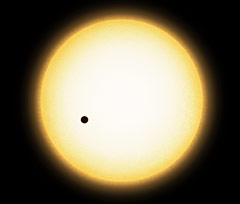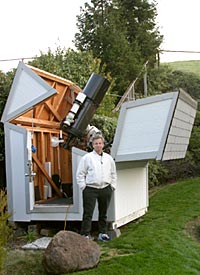
This artist's rendition shows the size of HD 149026b as it crosses the face of its Sunlike star. It blocks only 1/300 of the star's light, barely enough to be detectable by amateur astronomers.
Painting by Lynette Cook.
A day before an international team announced a new transiting planet orbiting the star HD 149026 on June 30th, California amateur astronomer Ron Bissinger detected a partial transit of that planet. He also detected partial transits during the next two opportunities, allowing him to produce a composite light curve of an entire event. This new find, HD 149026b, is now the third transiting exoplanet detected by amateurs.
"Ron's data are of excellent quality," says professional astronomer Gregory P. Laughlin (University of California, Santa Cruz), who is a member of the team that discovered the new planet. Laughlin has also helped organize the Transitsearch.org network to enable amateurs like Bissinger to detect such events. At the time the planet's discovery was announced, Laughlin predicted that amateurs would detect the transits, but he also noted that this planet was much harder to detect than the other two transiting exoplanets, HD 209458b and TrES-1. The new discovery thus highlights the increasing prowess of amateur astronomers armed with CCDs.

California amateur astronomer Ron Bissinger recorded this light curve of the star HD 149026. The light curve shows the changing brightness of the star as a small part of its face is covered by a crossing planet, named HD 149026b. The light curve is a composite of transit data acquired on the nights of June 29th, July 2nd, and July 5th. The red line is a theoretical model of the transit.
Courtesy Ron Bissinger.
To see if amateurs could detect these transits, Laughlin alerted Bissinger to the upcoming discovery announcement. This advance notice enabled Bissinger to observe HD 149026 on the night of June 29th, when a transit was predicted. Bissinger monitored the star's changing brightness with a 14-inch (36-cm) Celestron SCT and an SBIG ST-10XME CCD camera. He used Binary Maker 3 software, developed by David Bradstreet (Eastern University), to generate the light curve. Because the planet has a 2.877-day orbital period, he was able to observe partial transits again on the nights of July 2nd and July 5th. "Unfortunately I could not get a single complete transit due to the late onset of darkness, so I pieced the segments together," says Bissinger. "With some effort, other amateur observers could obtain similar or even better results."
"Millimagnitude accuracy is something most professionals only aspire to and never reach," says Arne Henden, director of the American Association of Variable Star Observers. "Bissinger's results show how the amateur-professional distinction has blurred, and opens up whole new areas of research to the amateur astronomer."
"That is truly beautiful work he is doing, and it is contributing to the precision of the radius measurement for the planet," adds veteran exoplanet hunter Geoffrey W. Marcy (University of California, Berkeley), who is also a member of the discovery team.
Amateurs detected their first transiting exoplanet, HD 209458b, ten months after professionals discovered the planet in 1999. TrES-1 was detected by European amateurs just eight days after the planet was announced last August. Bissinger's detection of HD 149026b came a day before the official announcement. "European amateurs get their crack at the transits from now through this weekend, and Japanese amateurs get their shot in two weeks," said Laughlin on July 6th.

California-based amateur Ron Bissinger, shown here with his observatory, caught three partial transits of HD 149026b across the disk of its host star.
Courtesy Ron Bissinger.
Last year, Bissinger and other amateurs in the Transitsearch.org network recorded anomalies in the light curve of TrES-1 transits. One possible interpretation was that the planet was surrounded by some kind of torus of dust. Hubble Space Telescope transit observations made last year by Timothy Brown (National Center for Atmospheric Research) and his colleagues also show anomalies in the light curve, strongly suggesting that the amateur data were not plagued by systematic errors. But Laughlin now says the most likely explanation is that the host star is magnetically active, so it has large sunspots and bright regions known as plages that add slight irregularities to the light curves.
 0
0
Comments
You must be logged in to post a comment.